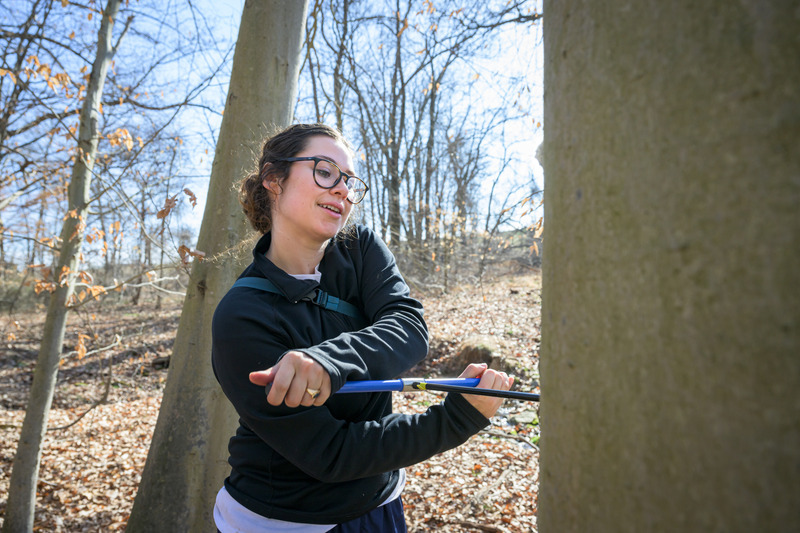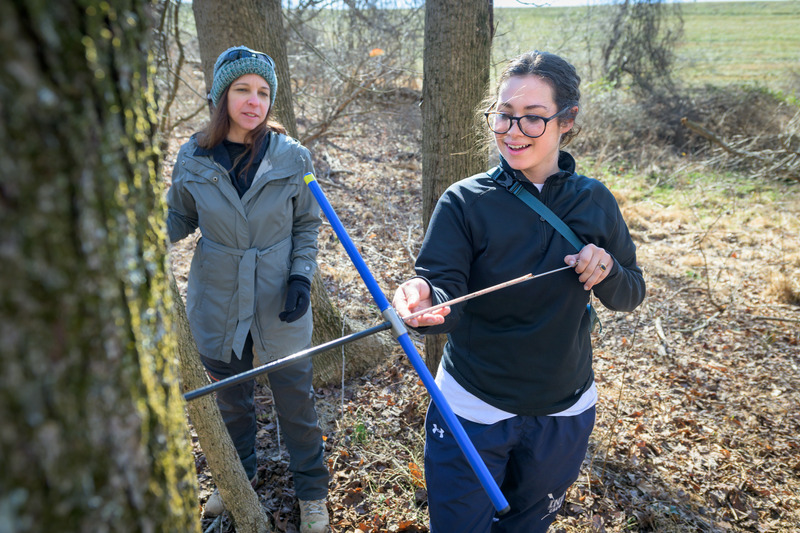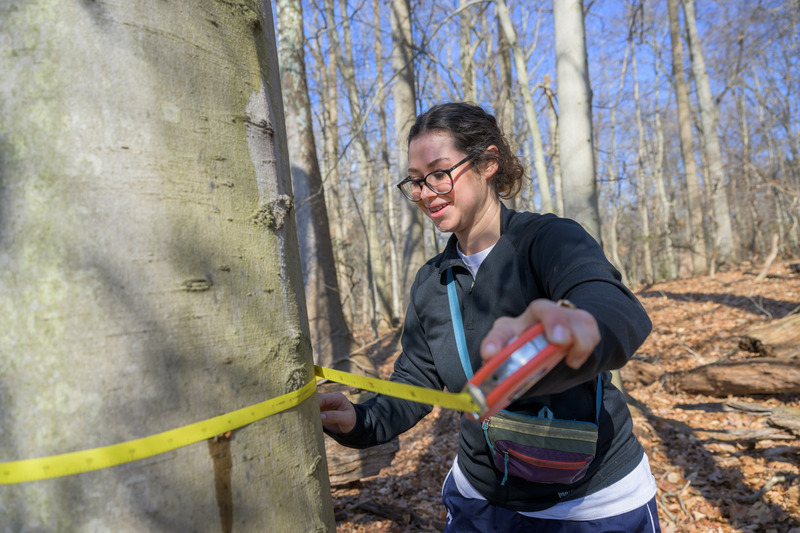


Analyzing urban forests
Photos by Evan Krape March 21, 2024
UD graduate student Kendall McCoach explores urban trees and carbon storage
As global temperatures continue to rise, scientists around the world are searching for different ways to combat climate change. One area of research that’s become popular with both governments and private industry is forest carbon storage.
Forest carbon storage relies on the ability of trees to sequester carbon dioxide from the atmosphere and store it in their trunks, roots and soil as a possible combatant for climate change.
Kendall McCoach, a graduate student at the University of Delaware, is researching how different urban conditions can affect a forest’s capacity to store carbon.
To pursue this research question, McCoach is looking at vegetation survey data from trees and shrubs. The Ph.D. in Plant and Soil Sciences student also uses dendrochronology, where she studies the rings in trees and aged wood to track tree growth in response to variations in environmental conditions.
“You extract a pencil sized core from a tree. That allows you to look at these rings that the tree produces year after year,” McCoach said. “We get a record of the tree’s growth and its responses to environmental conditions throughout its life; we can kind of look back in time in that way.”
By studying the rings on the tree cores, scientists can tell a lot about the tree’s growth. Fluctuations in isotope ratios can show a tree’s response to change in climate. Compressions in the wood can show changes in wind speed over time. By looking at the series of ring widths in a tree, McCoach and her collaborators know how much or how little the tree has grown in every year.
“With this data, we can correlate tree growth with environmental conditions like temperature, while also looking for tree growth differences between the forest edges versus the forest interior and between different cities,” McCoach said.
To paraphrase the old real estate saying — location matters. McCoach is interested in studying how tree growth and carbon sequestration can be affected by the urban forest’s location. A majority of the forests in the eastern U.S. are considered urban forests, so understanding how a forest responds to changing climatic and urban conditions is critical for better forest management and conservation.
“To accurately model the ability of trees to store carbon, we need to take into account the forest edges,” said Tara Trammell, John Bartram Associate Professor of Urban Forestry and McCoach’s dissertation advisor. “Kendall is looking at forests that are more urbanized than what we’ve seen in forestry research, and those conditions might change the way our forests are actually storing carbon.”

Additionally, McCoach is also using complex techniques to model the biomass of the forests. By studying the biomass, McCoach can see particular aspects of forests that might be more productive in storing carbon.
“I’m hoping that I can estimate the biomass of not just the forests I’m studying directly, but with a larger uncertainty, also estimate the biomass of forests in more northern and southern cities,” McCoach said.
“This research has large implications for the way we think about forests as a natural solution to climate change,” Trammell added.
The research that McCoach is undertaking requires lots of collaboration and effort from many different people. She emphasizes that her work would not be where it is today without Trammell’s guidance and immense sample collection help from UD undergraduate research assistants.
McCoach first learned skills in dendrochronology while attending the North American Dendroecological Fieldweek (NADEF). The NADEF consists of 10 days of in-depth field work using dendrochronology, followed by a conference to present everyone’s findings.
“NADEF was hugely impactful because I had the option to go to a more modeling focused group, so not only did I get this introduction to tree coring, but I got more detailed experience, which was really awesome,” McCoach said.
“The NADEF is a good example of graduate students getting intensive experience away from the University that they can bring back, while also meeting a lot of people in their field,” added Trammell.
McCoach’s involvement at the NADEF led her to another workshop in Arizona that focused on a new modeling technique for calculating biomass from tree growth data.
“We were all kind of newcomers to this modeling technique, so it was an opportunity to be on the same level with people who are really advanced in their scientific careers,” McCoach said. “I was able to take the data that I’d already obtained and get my own model set up using their modeling code, which was huge for me.”
McCoach’s project is also not restricted to the cities that border UD, but she has access to a larger network of forests, the FRAME (FoRests Among Managed Ecosystems) that spans from Springfield, Massachusetts, to Raleigh, North Carolina.
“The response of these urban forests to the conditions they’re already subjected to can act as a proxy for the response of larger rural forests to the conditions they might face in the future with climate change,” McCoach said.

Contact Us
Have a UDaily story idea?
Contact us at ocm@udel.edu
Members of the press
Contact us at 302-831-NEWS or visit the Media Relations website

